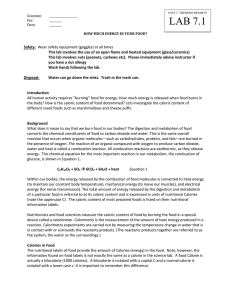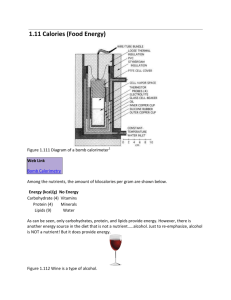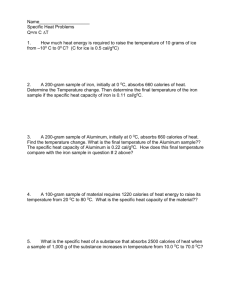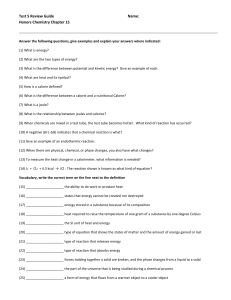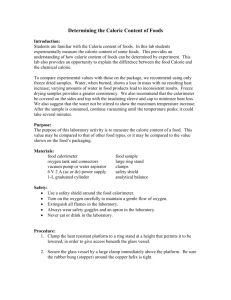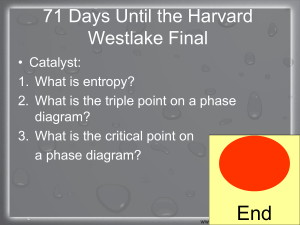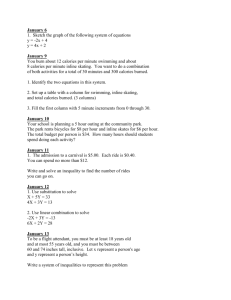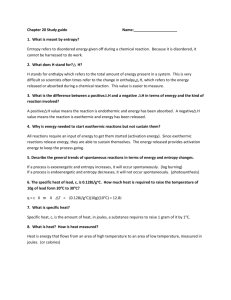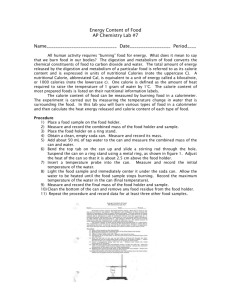Student instructions and lab report
advertisement
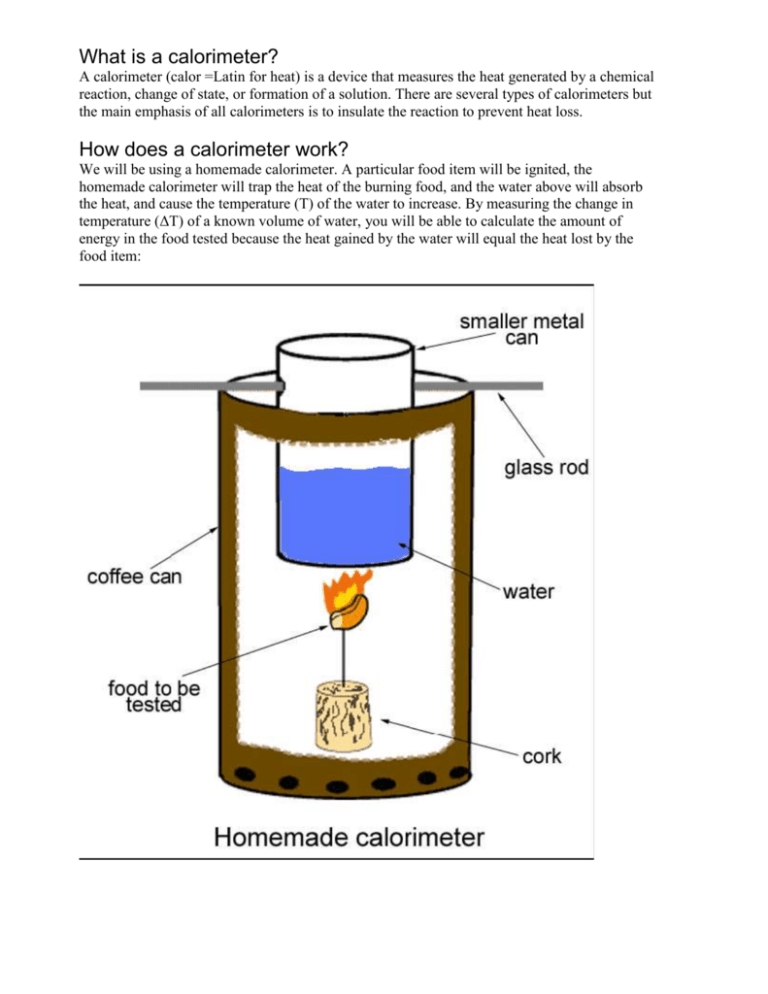
What is a calorimeter? A calorimeter (calor =Latin for heat) is a device that measures the heat generated by a chemical reaction, change of state, or formation of a solution. There are several types of calorimeters but the main emphasis of all calorimeters is to insulate the reaction to prevent heat loss. How does a calorimeter work? We will be using a homemade calorimeter. A particular food item will be ignited, the homemade calorimeter will trap the heat of the burning food, and the water above will absorb the heat, and cause the temperature (T) of the water to increase. By measuring the change in temperature (ΔT) of a known volume of water, you will be able to calculate the amount of energy in the food tested because the heat gained by the water will equal the heat lost by the food item: How can we calculate the amount of energy in a food item? Qlost by food = Qgained by water The energy gained by the water can be calculated as follows: Qwater = (m)(c)(ΔT) Q is the heat gained in calories (cal) m is the mass of water in grams (g) c is the specific heat capacity of water (1 calorie/g °C) ΔT is the change in temperature in degrees Celsius (°C) Procedure 1. Of the food items we will be testing, hypothesize which ones will have more Calories (energy). Can you rank the food items according to the energy content (from the highest to the lowest)? Record your prediction in the Laboratory Report. 2. Obtain a weigh boat and determine its weight. Record your data. 3. Obtain a food item and using the same weigh-boat, determine the weight of the food (wi). Record your data. 4. Using the graduated cylinder, measure out 100 ml of distilled water from the water bottle and pour it into the small metal can. 5. Measure the initial temperature of the water (Ti). You may have to leave the thermometer in the water for a while in order to get an accurate reading. Record your data in table 1. 6. Position the small can inside the large can and slide the glass rode through the holes of both cans. 7. Unfold the paper clip and insert it into the cork. 8. Gently wrap the paper clip attached to the cork around the food. It is better to have the food at a slight angle. If the food breaks, use another one; however, you will have to reweigh the new food item. 9. Place the cork with the food on a nonflammable surface. Put on your safety glasses and call the teacher. The teacher will help you light the food. It may take a while for the food to catch on fire. 10. As soon as the food catches fire, immediately place the coffee can around the burning food. 11. Allow the food to burn until it goes out. If possible try to keep an eye on it and if it goes out quickly (less than a minute), relight the food. 12. Once the food has finished burning, carefully stir the water with the thermometer and then measure the temperature again (Tf). Caution! The cans and water will be warm! You may have to leave the thermometer in the water for a while in order to get the highest reading. Record your data. 13. After the burnt food has cooled, transfer it to the original weigh-boat (use the forceps if necessary) and weigh the remnants (wf). Record your data. Laboratory Report 1. Can you predict how these food items rank according to their energy content (from the highest to the lowest)? 2. Data Table: Food Item Weight (Mass) of Food (g) Initial Weight (wi) Final Weight (wf) Temperature of Water (°C) Mass Initial of Temperatur Sampl e (Ti) eBurne d (Δw =wi – wf) Don’t forget to subtract the weight of the weigh-boat. Final Temperatu re(Tf) Change in Temperature(ΔT = Tf – Ti) Determine the Calories of the food: Energy or calories (cal) Food Calories (Cal) or kilocalories (kcal) calculations answer calculations answer calculations answer calculations answer calculations answer Qlost by food = Qgained by water The energy gained by the water can be calculated as follows: Qwater = (m)(c)(ΔT) Q is the heat gained in calories (cal) m is the mass of water in grams (g) c is the specific heat capacity of water (1 calorie/g °C) ΔT is the change in temperature in degrees Celsius (°C) *Remember that the density of water is 1g/ml therefore 1 g of water = 1 ml of water. Cal/g Questions: How many Calories are in each whole food item you tested? Were you able to determine the entire Calorie content of the food item? Why? Do you think the number of Calories you calculated is likely to be lower or higher than it really is? Explain why. What is the original source of energy in all of the foods tested?
